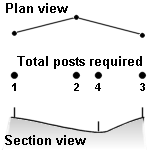Chain link fence (2 of 3)
Setting out and erecting the posts.
- First clear away all obstructions and ensure a reasonable ground level before pegging out the line of the fence with string. Clear away plants etc. from along the line of the fence, about 300mm (1 ft) on both sides of the line, more where the posts will go. The plants can be replaced after the fencing has been erected.
-
Roughly mark the position of the posts for the ends and any bends of your fence (1, 2 and 3 shown on figure). You now have the straight runs roughly identified. Look at the slope of the ground and mark any point where the angle of the ground level changes significantly (4 on figure). These are the main points where there MUST be posts.
- 1 and 3 being 'end' straining posts.
- 2 being an 'intermediate' straining post.
- 4 being a 'standard' post.
- An intermediate straining post is required in any straight run in excess of 69 metres (75 yards), evenly space such posts between the end straining posts.
- Additional standard posts are required between the straining posts to give a spacing of no greater than 3 metres (10 ft). Distribute thes
 e
posts evenly to fill the gaps between the straining posts.
e
posts evenly to fill the gaps between the straining posts. - Where the line of the fence curves, it is advantageous to fix 45° backstays (i.e. at right angles to the fence) to each post as there will be a certain amount of sideways force. Usually it is sufficient to ram these backstays straight into the ground at the required angle.
- Mark the position of the end straining posts and dig the holes for their foundations. In normal soil allow for the following foundations:
- Posts up to 1.40 m (approx. 4 ft 6in) the holes should be 450 mm (1 ft 6 in) square and 600 mm (2 ft) deep.
- Posts above 1.40 m (approx. 4 ft 6in) the holes should be 450 mm (1 ft 6 in) square and 750 mm (2 ft 6 in) deep.
- Holes for straining post stays should be 450 mm x 300 mm (1 ft 6 in x 1 ft) and 450 mm (1 It 6 in) deep.
 Cut
timber posts post and stay(s) so that the stay can be inserted into the post (figure right). Concrete posts and stays have the
joints cast into them during manufacture. When using angle iron, drill holes so that each stay can be bolted to the post.
Cut
timber posts post and stay(s) so that the stay can be inserted into the post (figure right). Concrete posts and stays have the
joints cast into them during manufacture. When using angle iron, drill holes so that each stay can be bolted to the post. - Erect the end straining posts and straining post stays. Ensure that the post is upright and that the stay is a firm fit onto the post. Check to ensure that the lower wire hole is about 10 cm (4 inch) above the ground level (or about 5 cm (2 inch) if the bottom of the fence is be buried). Ram the earth around the post or preferably embedded using large rubble or old bricks at the bottom of the hole with firmly compacted earth above. For even better results the posts should be embedded in concrete.
- Fix a taut line between the end straining posts and erect any intermediate straining posts and stays in a similar manner.
- Set out the standard uprights (at no greater than 3 m (10 ft) intervals) along the line, space them evenly.
- Dig the holes as previous and erect the posts ensuring they are upright.
- If you are going to bury the bottom of the fence, dig the trench between the posts, pile the earth behind the fence line.
